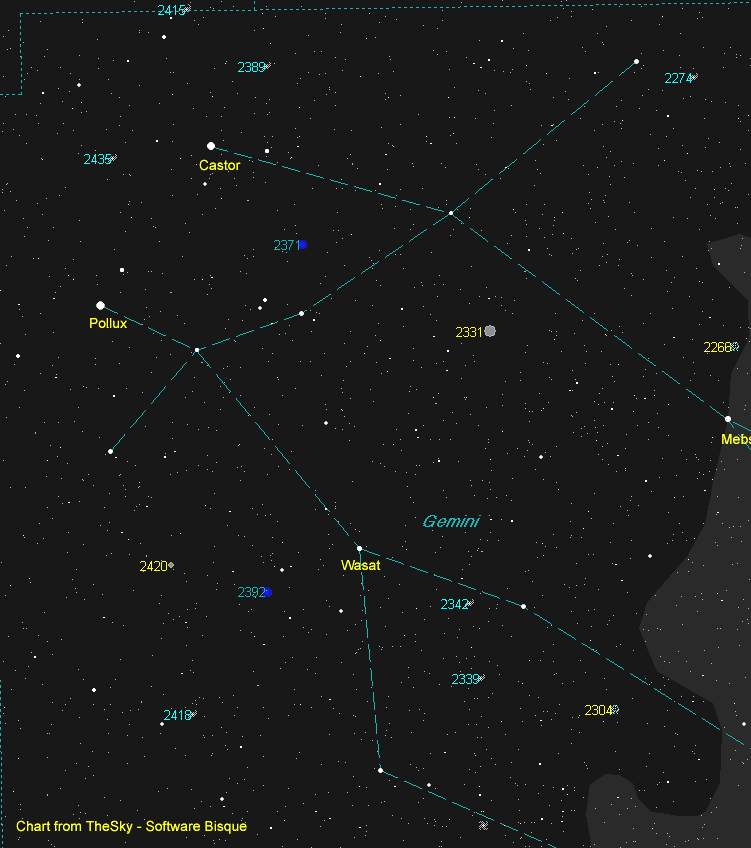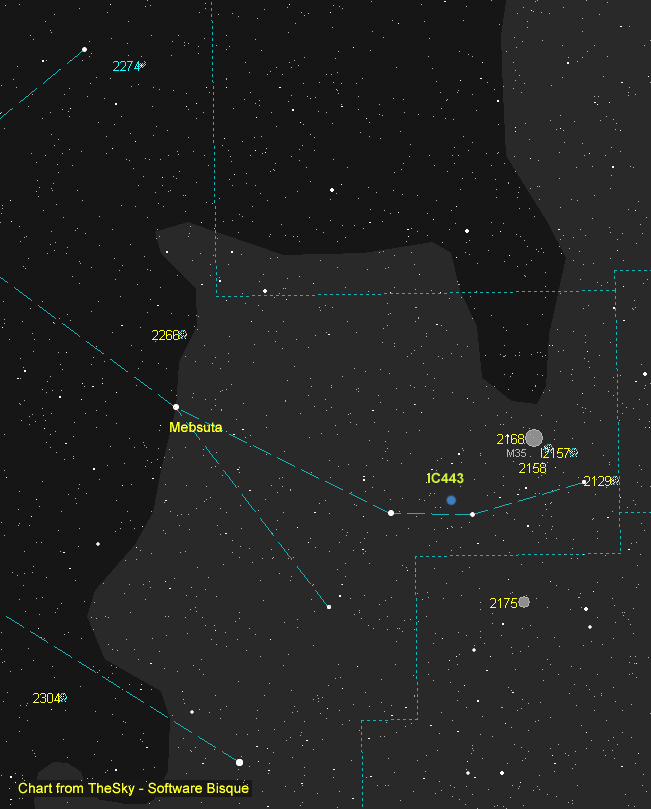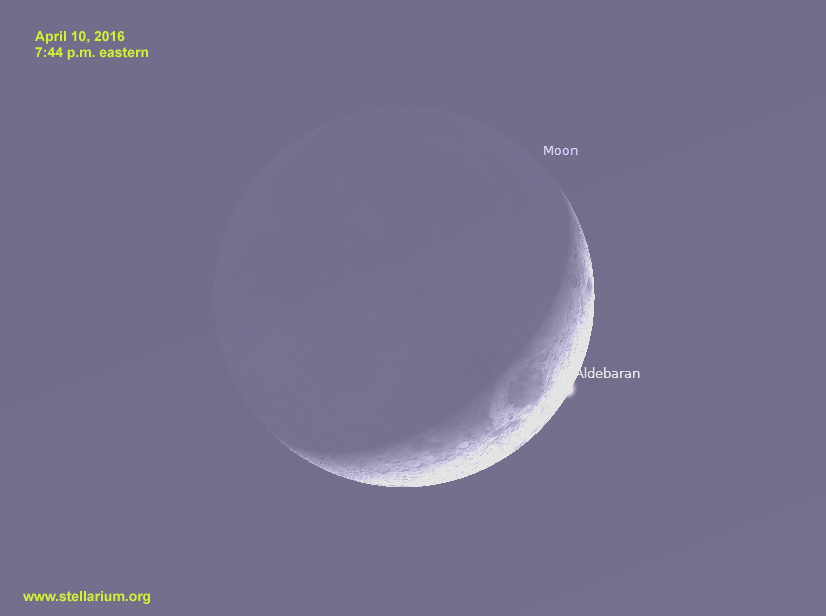Gemini Twins
After a long cold winter, we now get to enjoy some spring observing. This month we will look at the constellation Gemini the Twins. This constellation is one of Ptolemy’s 48 original constellations and in fact, the word Gemini comes from the Latin meaning “twins”. Dominated by the stars Castor and Pollux, Gemini’s outlines twin figures. Mythology states Pollux is the son of the mighty Zeus whereas Castor was a mere mortal. As the story goes, they were placed in the sky to be together for all time. Although the two stars might appear close in brightness, the physical properties are quite different.
The star Pollux a.k.a. Beta Geminorum shines at magnitude 1.16 and is a spectral class K0 orangey coloured star located 34 light-years from us. With an estimated diameter of 9 or 10 times that of our Sun, this giant has a surface temperature of 4,770 K and is in the process of fusing helium in carbon and oxygen in its core. Pollux seems to have an outer corona comparable to our Sun. This star is also the parent sun to an exoplanet measuring about 2.9 times that of the planet Jupiter. Pollux b resides 1.6 astronomical units from the main star and takes 1.61 years to complete a circular orbit.

Located to the upper right of Pollux is the star, Castor. Although regarded as the alpha star, Castor shines at magnitude 1.58 and is estimated to be 52 light-years from us. With a spectral class of A1, this white coloured star has an estimated surface temperature of 9,500 K or double that of Pollux. Castor is truly unique as it is a combination of three pairs of stars in a very unique dance. Through the eyepiece of a telescope, Castor shows a close companion. Both components Castor A & B are themselves doubles and possess a mysterious third companion themselves as we introduce Castor C otherwise known as YY Geminorum. This is, in fact, a spectroscopic double star consisting of nearly identical spectral class M1 dwarfs. Although components A & B orbit each other in 445 years, component C orbits A & B every 14,000 years.
One of my favourite open clusters is M35. Located near the foot of Castor (right) side of the twins, this amazing splash of about 200 stars is located 2,800 light-years away and glows at magnitude 5.2. Astronomers have dated the cluster at 150 million years of age. Occupying the area of the full moon, M35 can easily be seen in binoculars but a wide-angle telescope is required to glimpse M35 together with NGC 2158. Here is a much smaller and fainter open cluster at magnitude 8.6. NGC 2158 is a densely packed group of stars which is estimated to be ten times older than M35 and four times farther away.
One of the best examples of a planetary is the Eskimo Nebula or sometimes called the Clownface Nebula. Also catalogued as NGC 2392 or Caldwell 39, this bi-polar planetary nebula is estimated to reside 2,870 light-years from Earth. In small telescopes, the Eskimo appears as a fuzzy bright greenish object but larger instruments will reveal more detail. About 10,000 years ago a Sun-like star eventually ran out of fuel and grew to become a red giant. Over time the weak gravity allowed the release of its outer layers into space thus forming this celestial portrait.

The Medusa Nebula is another planetary nebula 1,500 light-years from Earth. It is estimated to be about 8,000 years old and still growing as it fades. The strand-like features of gas and dust resemble the snakes from the mythological Medusa’s head. The overall nebula measures some 4 light-years wide but is diffuse thus making it a difficult object to observe.
We now move on to the remains of a tremendous explosion. IC 443 is a supernova remnant lying about 5,000 light-years from Earth. Dubbed the Jellyfish Nebula, we see the remains of a star that disintegrated in a gigantic supernova explosion as much as 30,000 years ago. The cloud of remaining star stuff has expanded in size to about 50 arc minutes – that is almost two full moons placed side by side. This angular measurement yields a physical width of some 70 light-years wide. Although this is a photographic object, narrowband filters such as an OIII or UHC should help to see it visually.
Delta Geminorum is a close pair of stars separated by only 6 arc seconds. This double star is named Wasat which comes from the Arabic meaning “middle” is about 60 light-years from us. The system consists of a pale white magnitude 3.5 star together with a magnitude 8.2 orange dwarf that might be difficult to see in small telescopes. The dwarf is estimated to take as much as 1,200 years to orbit its primary.
The planet Mercury can be glimpsed low in the west after sunset on April 1 and climbs higher each night till it reached its greatest elongation of 20 degrees from the Sun on the 18th. It should be fairly easy to locate as it brightens to about zero magnitude. After the 18th Mercury begins to sink back towards the Sun. Save the date for May 9 as Mercury will transit the face of the Sun. If you need to purchase a solar filter, now is the time. More on the transit in next month’s column. The planet Jupiter is well up in the eastern sky after sunset. On the first of the month, the Jupiter sets at 4:54 a.m. local time. As always please refer to the Observer’s Handbook 2016 pages 232-233 for transits and shadows of the four main Galilean moons. Also on the first of the month, Mars will rise at 12:30 a.m. local time along with Saturn about forty minutes after. Both are now in the constellation Scorpius with the bright red star Antares adding to the view. Venus is extremely low in the eastern sky.

The star Aldebaran plays hide and seen again with the 17% lit moon on April 10. The star will reappear from the occultation on the western limb at about 7:42 p.m. eastern but start watching a few minutes earlier as the reappearance will be quick. This is also a great photo opportunity. The annual Lyrid meteor shower occurs from Apr 19 to 25 and peaks on the night the 22nd into the morning of the 23rd. This is not a very strong shower with only 20 meteors seen per hour (ZHR=20) and they will strike the atmosphere at 48 km/sec. However, the full Flower Moon occurs the night before on the 21st so this should wash out many meteors from view. The new moon occurs on April 6th.
Until next month, clear skies everyone.
